Do you want to know the secret behind building a blog that gets backlinks, ranks for important keywords and receives tons of organic traffic over time?
Two words: evergreen content.
These two words are the backbone of our strategy here at Ahrefs. It’s how we’ve grown our blog from 15,000 visitors/month to >200,000 visitors/month:
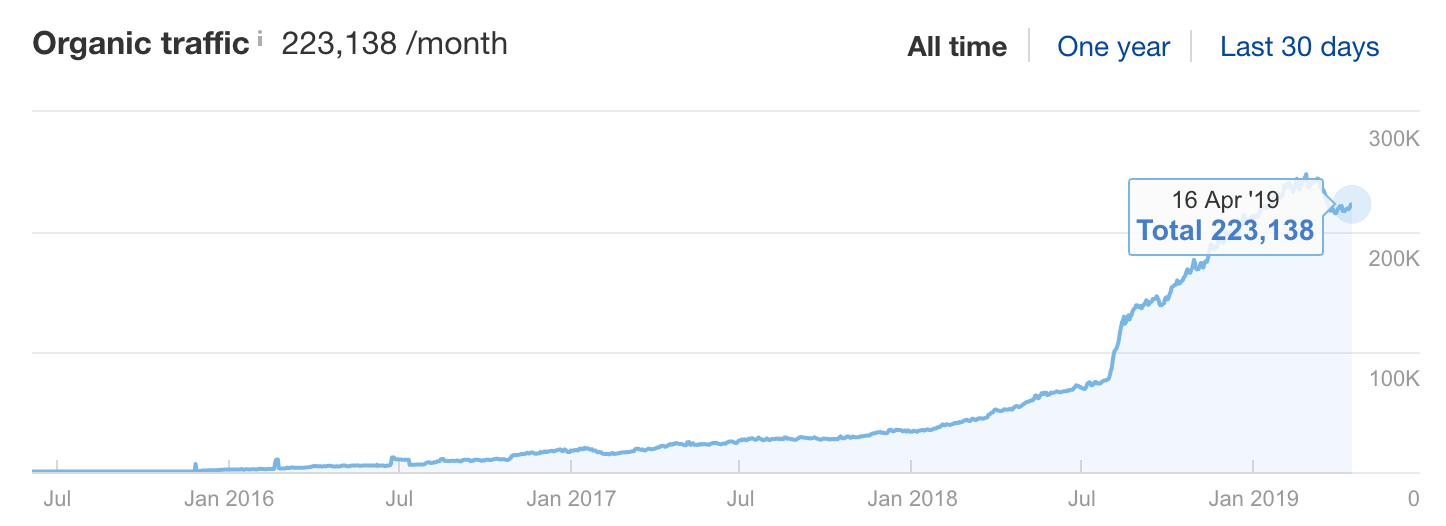
In this article, I’ll explain what evergreen content is, why it’s important and how you use it in your content marketing strategy.
Before that, let’s get some basics down.
What is evergreen content?
Evergreen content is content that doesn’t go out of date. It revolves around a topic that’s always relevant to readers, regardless of the current news cycle or season. Its name comes from the evergreen—a plant that retains its green leaves all year round.
That makes sense. But if you take a closer look at that definition, you’ll notice that it talks about two different things:
Content and topics.
This is an important distinction that most articles about evergreen content fail to mention.
Evergreen topics
Evergreen topics are those with consistent interest and search volume over time.
Here are some examples of evergreen topics:
- “How to lose weight”—It doesn’t matter if it’s 2019 or 100 years from now. People will always want to lose weight.
- “How to fry an egg”—Eggs are a stable part of English breakfasts and many other of the world’s favorite meals. People aren’t going to stop eating fried eggs anytime soon, which is why there’s consistent interest in learning how to fry one.
- “Football scores”—Football matches (sorry, US folks) get played all the time, and football fans are always interested in the latest scores.
Examples of non-evergreen topics might be:
- “US presidential elections”—The elections happen every four years.
- “Where to buy easter eggs”—Likewise, Easter happens only once a year.
- “Olympics”—If you count both the summer and winter Olympics, this happens once every two years.
- “Khabib vs. McGregor”—This was a one-time event in October 2018.
Evergreen content
Evergreen content is content about an evergreen topic that never goes out of date.
Here are some examples of evergreen content:
- 10 Ways to Lose Weight Without Dieting—The fundamentals of losing weight don’t change much. Burn more calories than you consume, and you’re golden. That’s why this piece of content is still evergreen, despite not being updated since 2007.
- How To Fry an Egg—This post was published in 2017. But it’s still evergreen. The process doesn’t change all that much, and there’s no need to update the post.
- Football scores—Now you’re expecting me to show a piece of content for “football scores,” right? This is where the difference between evergreen topics and content starts to become clear, because…
There is no evergreen content about the evergreen topic of football scores.
If you were to write about the latest football scores today, it would be irrelevant in a week from now, despite ongoing interest in the topic.
I’ll come back to that later and explain a way to deal with this.
Why is evergreen content important?
When Donald Trump won the election in 2016, the New York Times reported it.
Because they were one of the first few to break the news, their site saw a massive spike in traffic.
But that only lasted for a couple of months. As people started coming to terms with Donald Trump’s win, they were no longer interested in the topic of “Donald Trump winning the election.”
As such, traffic to that article plummeted.
Every time you publish this kind of post, and it gets widely shared, you get an initial burst of traffic. We call that the “spike of hope.” Over time, as interest wanes, this quickly degenerates into a “flatline of nope.”
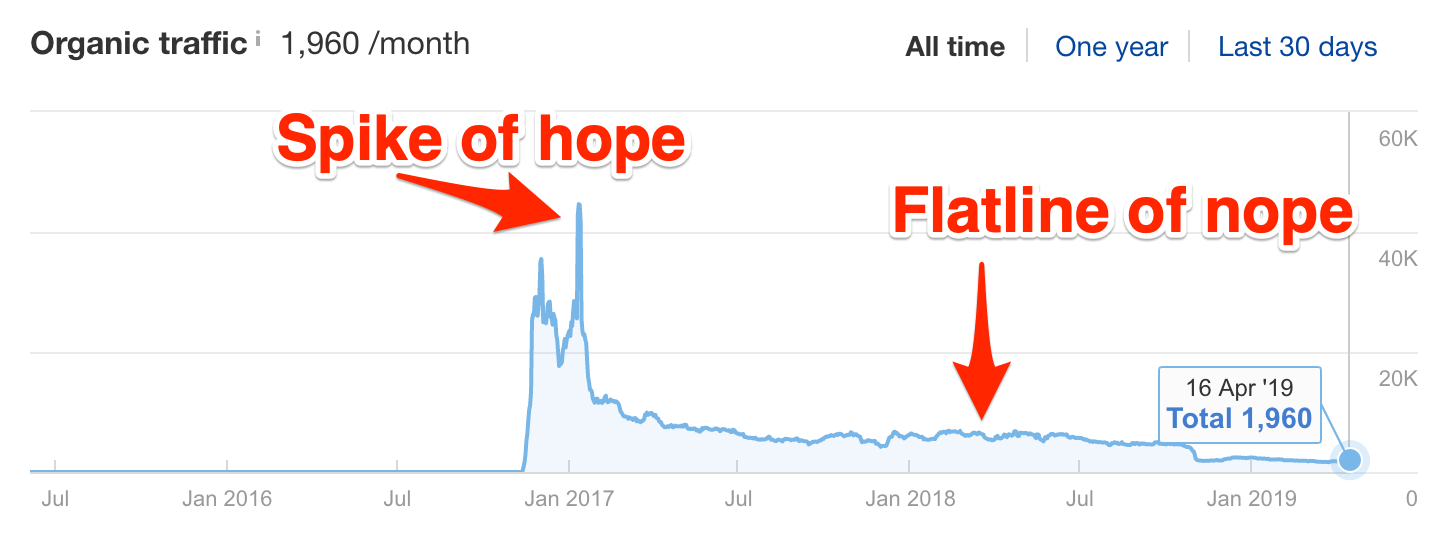
This puts you on the hamster wheel of content creation. You have to keep publishing. Once you stop, your traffic will drop.
And that’s precisely why you should create evergreen content around evergreen topics. It helps you:
- Do less work. You don’t have to change or update the content often, which saves time.
- Get regular organic traffic. Google’s job is to provide answers to people’s queries. If the content is out-of-date, it won’t rank. Creating evergreen content is your best bet if you want to attract organic traffic to your post month after month, year after year, and not see a decline in traffic after a month or two.
This is what we do at Ahrefs.
We never cover news, fads or controversial issues that people won’t care about next week. We only target evergreen topics and do everything in our power to create content that is as evergreen as possible.
How do you do it? It’s a two-step process:
Editor’s note
If you’ve ever wondered why we never write about Google algorithm updates, this is why. 🙂
Google pushes algorithm updates all the time. So, while there may be significant interest in the Panda/Penguin/Medic/Florida/[insert another ridiculous name here] update this month, often nobody cares by the next.

Step 1: Find evergreen topics
Finding evergreen topics is all about staying away from trendy topics and focusing on topics with consistent search traffic potential.
To do that, you have to do keyword research.
Here’s how.
a) Find keywords with search volume
Brainstorm a few topics you would like to target on your blog. Enter those topics into Ahrefs Keywords Explorer (or any other keyword tool of your choice).

You can also look at the different keyword ideas reports to see if there are other evergreen topics you could target:

Look at their search volumes. Is there enough search potential?
If there isn’t, it may just be that people are searching for the topic in some other way. To check if that’s the case, look at the Parent topic.
The Parent Topic determines if you can rank for your target keyword while targeting a more general topic instead.
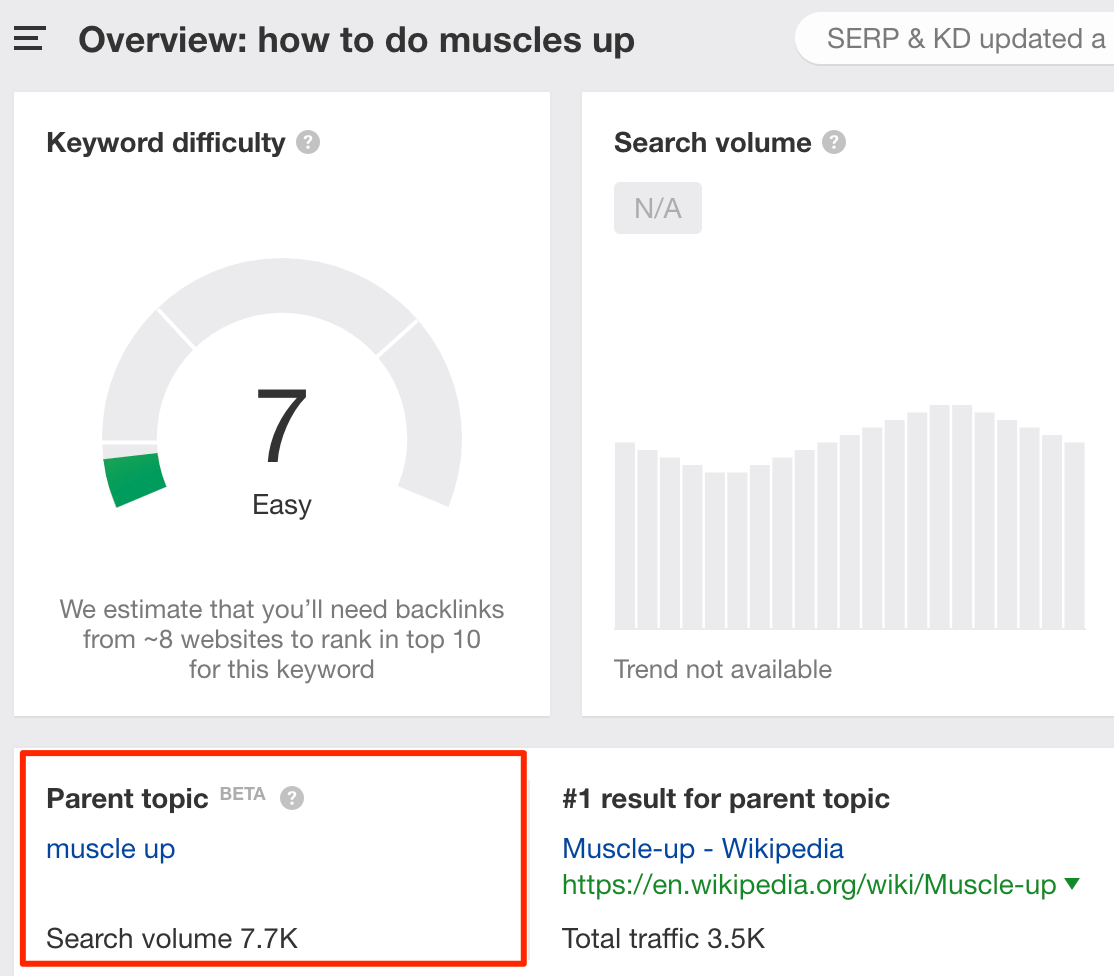
You can also take a look at the top-ranking pages. Are they getting lots of traffic? If so, this might be an evergreen topic.

Learn more in our guide to keyword research.
b) Check for a positive trend over time
The keyword may have a decent search volume. But you’ll want to make sure that the topic is evergreen.
That means it shouldn’t be:
- On a declining trend;
- Seasonal.
With tools like Google Trends, you can easily see if a topic is gaining or losing popularity over time. For example, it’s obvious that keywords like “Christmas gifts” are seasonal:

The keyword “Christmas gifts” spikes every December.
Whereas the keyword “website templates” may have a high search volume, but it’s a topic that is declining in popularity as time passes:

You can also use the trend graphs in Keywords Explorer to see the popularity of topics. For example, there are fewer searches and clicks on results for “website templates” today than there were in 2017:
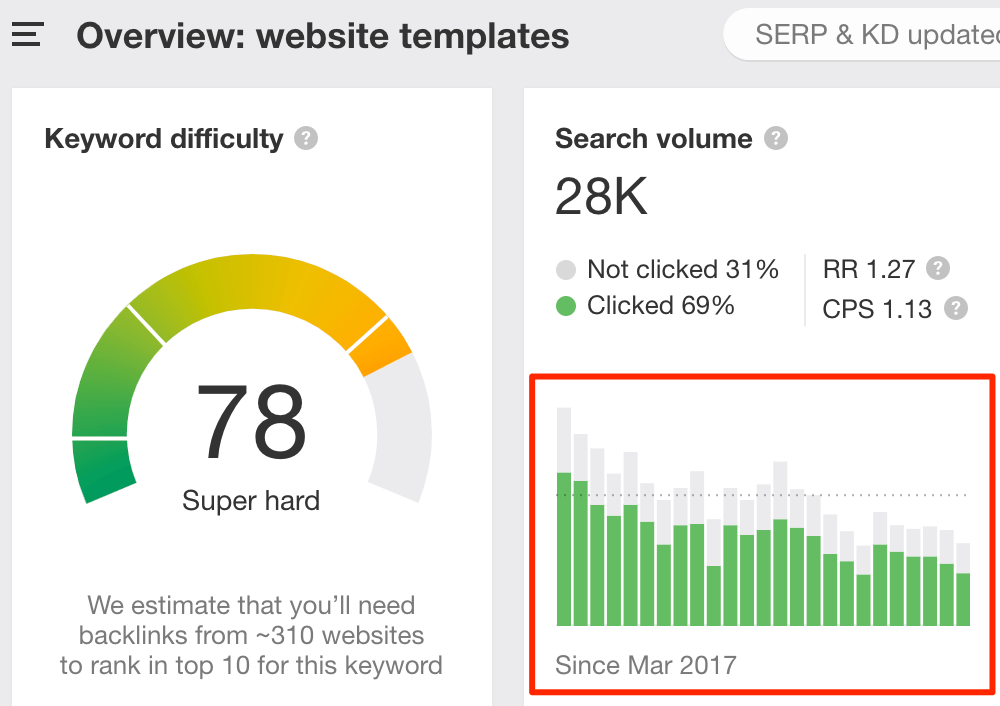
c) Check for consistent search intent
Search intent is the objective a searcher has when entering a query into Google.
If the search intent for a keyword is unclear or is likely to change, then there will be a lot of volatility in rankings. In that case, even if your post is technically “up-to-date,” Google may not see it as being an up-to-date representation of what people want to see, and thus your rankings will suffer.
Before you create any piece of content, check the ranking history graph in Keywords Explorer. If the intent is unclear, the SERPs will be volatile (i.e., pages will jump around in rankings).
Take a look at the keyword “football”:
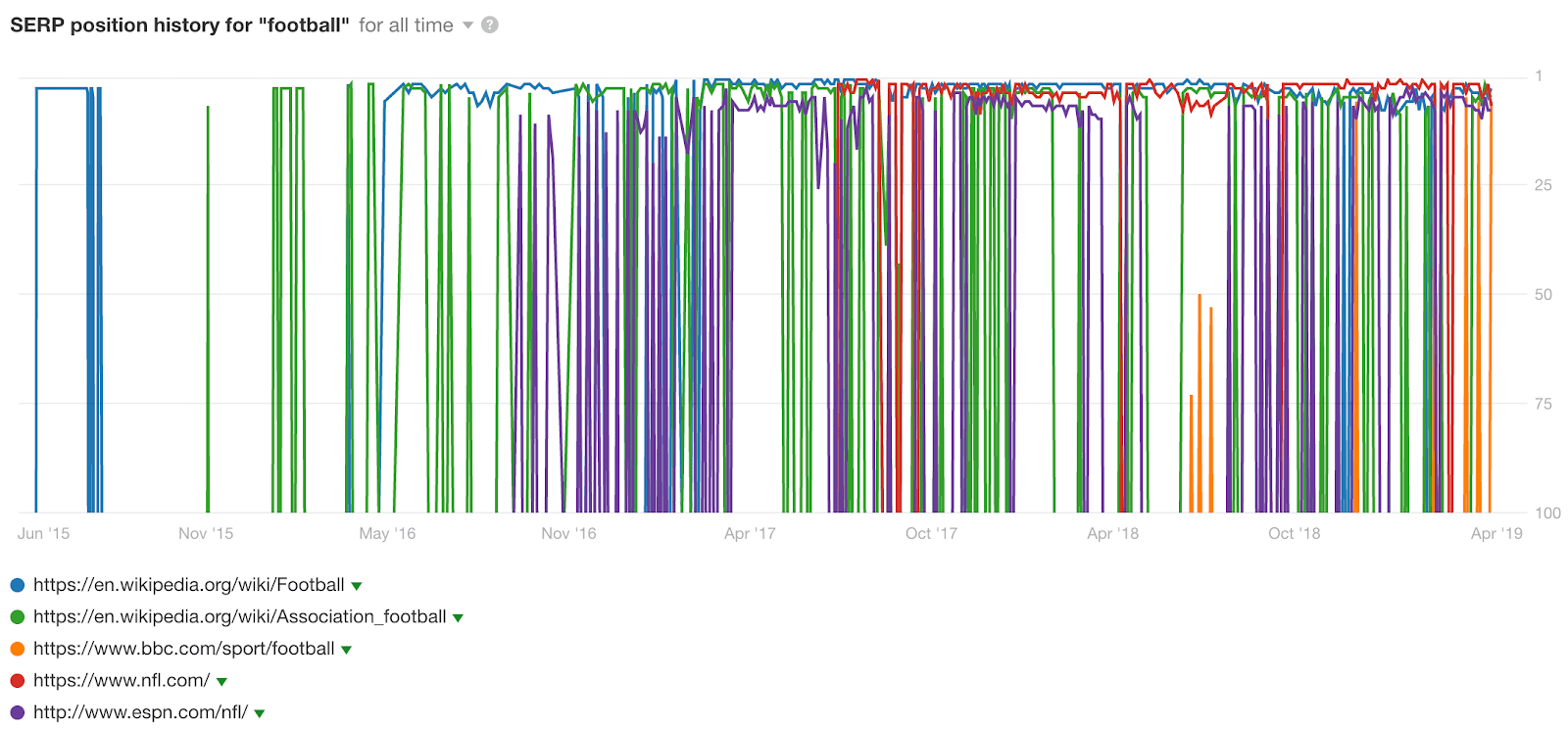
Compare that to something like “buyers journey”:

The colorful rainbow patterns in “football” indicate that there is high volatility when it comes to intent.
If the topic you’re targeting has a SERP position history that looks like that, it’s probably not a good topic to target.
Step 2: Create evergreen content
In a sense, creating evergreen content is the easy part.
You just have to create something useful that will stand the test of time. As Ryan Holiday puts it, “timelessness must be your highest priority.”
This is not hiring a writer on Upwork, publishing a 500-word article and calling it a day.
Maintaining evergreen status in the eyes of search engines like Google means being the best result today, tomorrow, and many months from now.
How do you do that?
a) Create 10X content
Google’s job is to deliver the best result for the search query.
To be the best result, you’ll need high-quality content (after all, low-quality content is easy to beat in the SERPs.)
Not only that, it has to be way better than everything else on that topic. In the marketing world, we call this “10X content”.
If your content is just like everyone else’s (1X), someone will come along and compete with you rather easily. If it’s a bit better than what’s already out there (2X), that’s much better—maybe it’ll last a few weeks, months or years, depending on your luck and how competitive that keyword is.
But if it’s the best piece of content on that topic (10X), your chances of maintaining rankings in the long-term are much, much higher because the bar is set so high.
Now, how do you create 10X content?
That warrants a whole blog post of its own. But we’ve found that 10X content tends to have these characteristics:
- Quality. Is the website design great? Is the content easy-to-read? Is it interesting, entertaining or useful? Does the content actually solve the problem?
- Uniqueness. Why would someone choose your content over others?
- Authority. Are you an expert in this niche/topic?
So, keep that in mind as you’re creating your own piece of 10X content.
If you want to learn more about creating awesome articles, check out these guides:
b) Avoid angles with a short lifespan
Some content marketers love referencing pop culture in their articles. You see this happening with popular TV shows like Game of Thrones. For example, take a look at this article on what Jon Snow can teach us about content marketing.
In this case, the topic of content marketing is evergreen. But the content isn’t. Once the Game of Thrones hype dies down, this article becomes forgettable.
This is probably part of the reason why it doesn’t rank at all:
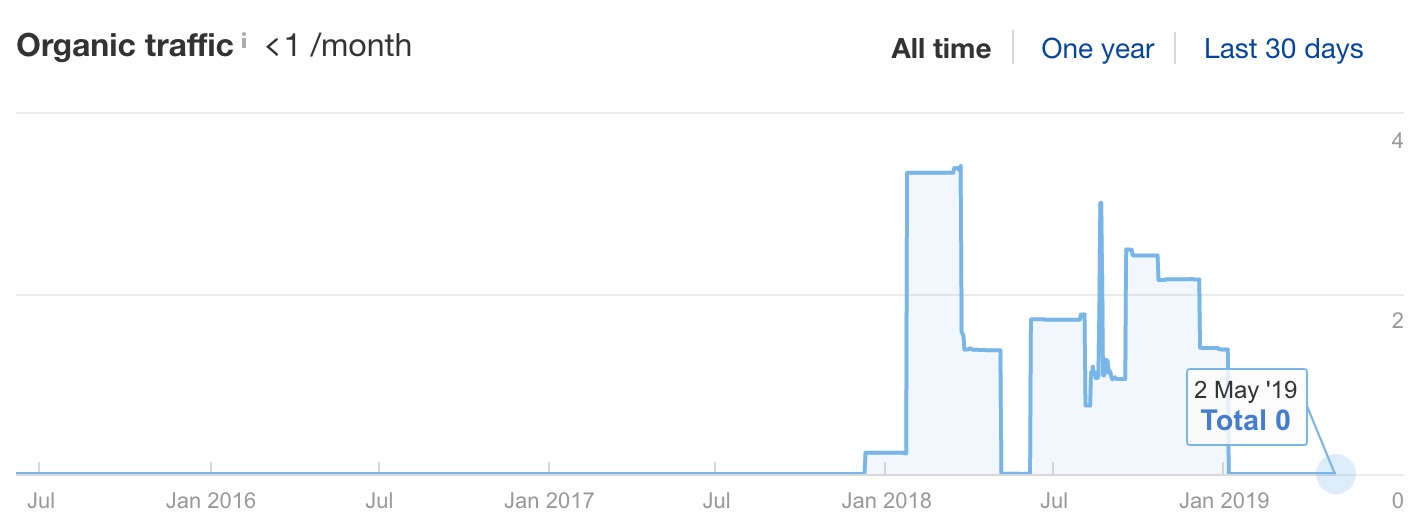
The main reason marketers do this is because of newsjacking. According to David Meerman Scott, newsjacking is the art and science of injecting your ideas into a breaking news story, so you and your ideas get noticed.
But while this may lead to a short-term spike in traction and traffic, it won’t lead to traffic in the long-term, since the content isn’t evergreen.
To prevent this problem, avoid trendy content angles or references in your content. That means references to Connor McGregor and Game of Thrones are out.
Sidenote.
This doesn’t apply to every type of content. If your goal is to achieve virality or cover important news, then you don’t have to avoid such references.
c) Avoid using language with a short lifespan
If possible, it also makes sense to avoid words and phrases like these in your content:
- “Earlier this year”
- “Last month”
- “Yesterday”
- “201X”
Such phrases only serve to date your content.
However, I’m sure you’ve seen many sites intentionally using years and dates in their post titles. This is something we often do too. For example, see our list of top Google searches.

It sometimes makes total sense to do this because people often search for queries containing the current year (e.g., “SEO in 2019”).
By using the current year in your title tag, you increase the relevance of your post. This can lead to higher rankings and more search traffic… for a while.
How to maintain your content’s evergreen status
If you apply every step above, it will be enough to keep your content evergreen for months, years or even decades (at least for most evergreen topics).
But for the fast-moving ones, this isn’t enough.
Take “football scores,” our earlier example.
It doesn’t matter what you do with this page. You could somehow write a 20,000-word article about football scores, build tons of links to it and you can bet it’ll be out of date by the end of the next match.
This is an example of a fast-moving evergreen topic. That means there is consistent interest in the topic over time, but any content about the topic will grow stale very quickly.
So, how do you keep an eye on and maintain your content’s evergreen status, especially for these fast-moving topics?
a) Track your rankings
Rankings are a proxy to relevance.
If Google drops your rankings slowly but surely over time, then it’s a telltale sign that while the topic may be evergreen, your content isn’t.
To keep an eye on this, you can use Rank Tracker (or any other rank tracking tool).
At Ahrefs, we usually track the main keyword we’re targeting for that page:

Sidenote.
You should do this for any topics about which you create content, not just the seemingly fast-moving ones. This will ensure that you’re alerted whenever your content’s evergreen status runs out. That will happen at some point because there is no such thing as a topic that never changes. Topics like “how to fry an egg” may seem like surefire evergreen topics, but who’s to say we won’t be frying eggs with laser beams in the year 2194?
b) Refresh your content
When your content’s evergreen status runs out, then you’ll have to look at the content and figure out why it’s no longer relevant in the eyes of Google.
Usually, it’s because some part of it has become outdated, like:
- Stats;
- Process;
- Screenshots;
- Links (broken/irrelevant/etc.);
- Year in the title.
Sidenote.
Many SEOs use the quick fix of changing the year in the title once the clock rolls over at midnight on New Year’s Eve. We prefer to remove years in titles once the new year hits. It seems more honest.
You should also look at the pages that have leapfrogged you in the SERPs. Google’s goal is to serve the best, most relevant result for the query, and the pages that now outrank you could contain clues on what’s missing from your post.
So, ask yourself: What do they have that you don’t?
Consider including those topics or points in your post.
pro tip
Looking for a way to quickly identify subtopics that you may have missed?
Use Ahrefs’ Content Gap tool to find the keywords for which other top-ranking pages rank, yet you don’t.
Just paste in some of the top-ranking URLs, set the mode to “Prefix,” add your URL in the bottom box (labeled “But the following target doesn’t rank for”), and hit “Show keywords.”


In this case, it looks like we should probably add a section with “basic SEO tips” to our list of SEO tips.
All that’s left is to refresh, republish and repromote it.
At Ahrefs, this is something we do all the time. The field of SEO is relatively fast-moving, and many of our articles end up staying relevant for a year or two before they need a refresh.
Nevertheless, we’ve seen tons of good results from applying this strategy. In fact, it is part of our core strategy for the Ahrefs blog.
We’ve updated this post on evergreen content several times!
Here’s another example. Take our post on anchor text.

As you can see, traffic to the post was steadily decreasing over time. Then, on February 26th, 2019, we updated the post with fresh data and studies.
Look at the massive uptick in traffic going to the post again.
This is what it looks like if you continue to keep your articles evergreen.
There are also a handful of articles we update much more regularly, and these are our top Google, Amazon, YouTube and Bing searches posts.
We update these posts every month because the topics are fast-moving. People expect fresh data, and Google is quite happy to stop sending traffic our way should they become out of date.
How do we know?
Because it was exactly what happened to us.
We first published the top Google searches post in April 2017. It ranked well. Then, rankings and traffic started to drop.
So, we rewrote, republished and repromoted the post. Here’s what happened:
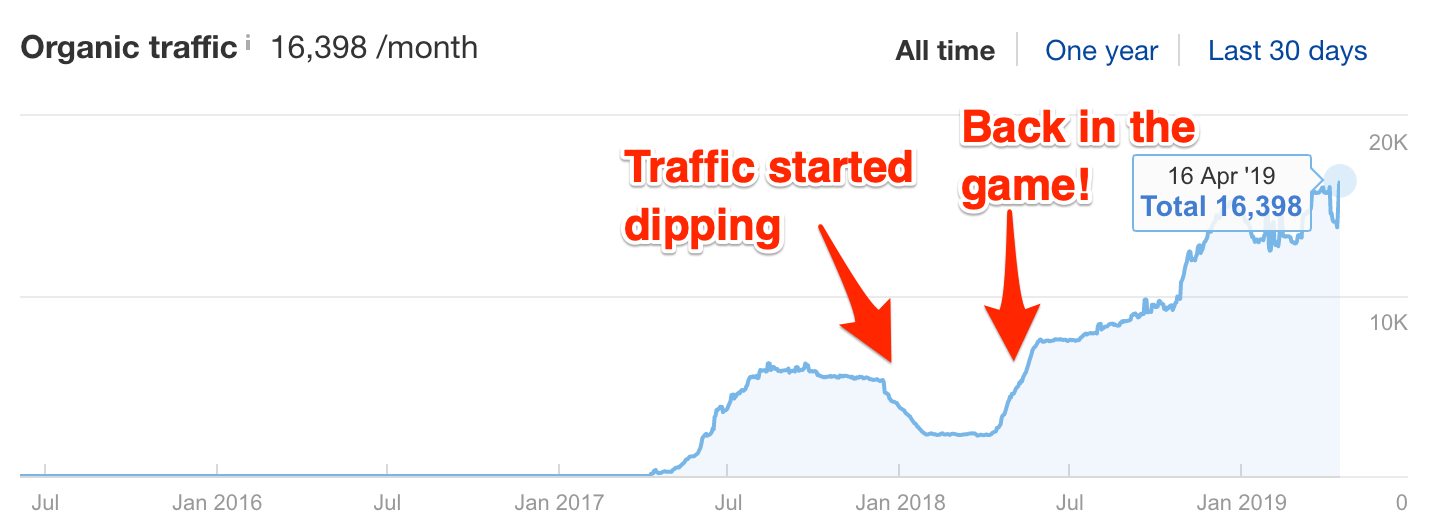
It was a simple fix, but one we wouldn’t have even known about if we didn’t track rankings closely in Rank Tracker.
We’re not the only ones who’ve had success with this tactic either.
Benjamin Brandall from Process.st refreshed his article about Dropbox vs. Google Drive in 2016, after not updating for two years. The result? Within four days, the page climbed from #8 to #3 in Google for its target keyword, and traffic increased by 468%.

You can see the step-by-step process on how to rework and repromote your content in Nat’s guest post on our blog.
c) Build links
Links are essential for evergreen rankings because pages with fewer links are easier to outrank.
How do we know? Because there’s a clear correlation between rankings and almost every backlink metric.
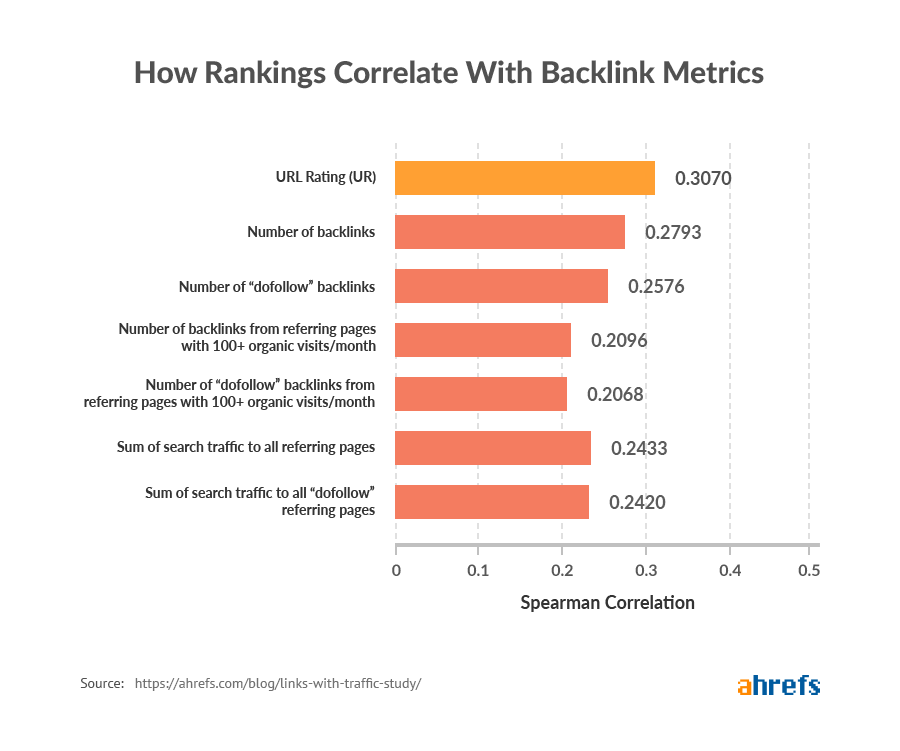
At Ahrefs, we would love to be able to outrank Moz’s Beginner’s Guide to SEO. But this is almost impossible because that guide has accrued an insane amount of backlinks.

As a result, it ranks #1 for almost every beginner SEO query there is. Just look at its rankings for the keyword “SEO” over the past few years:

Now, this is an extreme example. Most pages don’t need ~11,000 referring domains to rank. But it does illustrate why links are so important.
No matter how often you update or refresh your page, if it has only five backlinks, then it’s not going to be hard for someone to come along and outrank you.
This causes your page to jump around in the SERP, and your traffic to fluctuate.
So, while you may have successfully created evergreen content around an evergreen topic, you won’t have evergreen rankings to match, which defeats the whole point of doing this!
To get a rough sense of how many links you may need to crack the first page, paste your target keyword into Ahrefs Keywords Explorer. Look what it says under the Keyword Difficulty score.
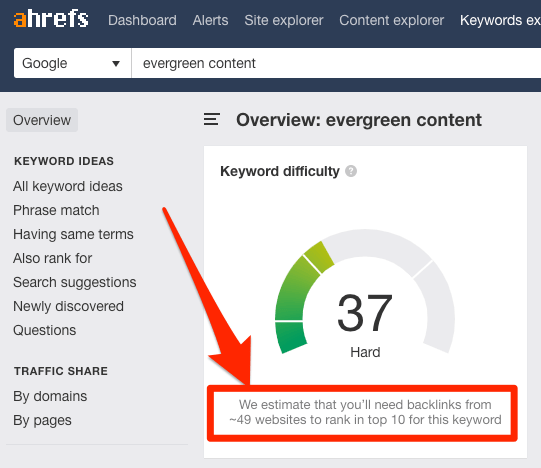
IMPORTANT. This is only an estimate. Please treat it as such.
Here are some resources to help you build more links to your site:
Final Thoughts
Jeff Bezos once said, “focus on things that don’t change.”
These are your evergreen topics.
If you want to get consistent traffic coming to your blog over time, and not tear your hair out publishing ten articles a week, you should target evergreen topics. Then, work to maintain their evergreen status by republishing and repromoting often.
Are you using evergreen content in your content marketing strategy? Let me know in the comments!
Shows how many different websites are linking to this piece of content. As a general rule, the more websites link to you, the higher you rank in Google.
Shows estimated monthly search traffic to this article according to Ahrefs data. The actual search traffic (as reported in Google Analytics) is usually 3-5 times bigger.
